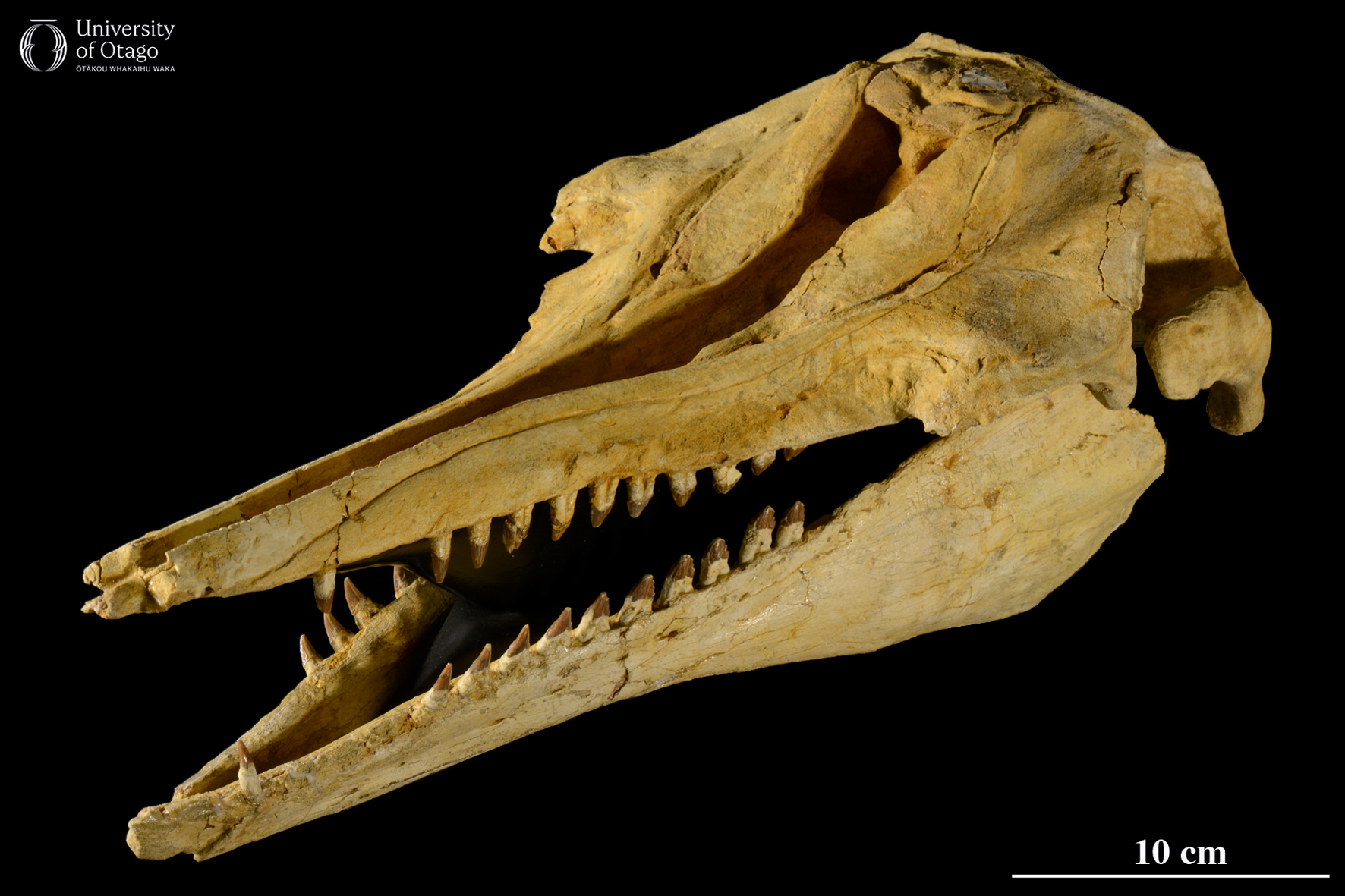22 Archaic dolphin connects oceans of Zealandia to endangered river resident
Cetacea, Waipatiidae: Waipatia maerewhenua
The seas around Zealandia were rich with a diversity of whale and dolphin species during the Oligocene. The beds of these ancient seas were later uplifted and now form the iconic limestone landscape of North Otago and South Canterbury. In the early 1990s Ewan Fordyce developed a field program supported by the National Geographic Society which sought to learn more about the diversity of life in these ancient seas from the fossils in these Oligocene rocks. By 1994 the bones from a fossil dolphin named Waipatia maerewhenua had been described, revealing an incredible connection between the fossils of North Otago and a species living today in the Ganges River, India.

Skull of Waipatia maerewhenua (specimen OU 22095). Image credit: RE Fordyce. |
The location of the Waipatia maerewhenua fossil was first revealed when an earbone and some teeth were found in an outcrop of limestone. Ewan Fordyce, Andrew Grebneff and Bob Connell spent two days excavating the fossil to reveal a skull lying upside down, with the upper jaws crossed over the skull. Many loose teeth were found along with more ear bones and a few fragments of bones from the skeleton behind the head. In the laboratory, it took Andrew Grebneff several months to excavate all the bones from the rock.
 |
Did you know there is a 3D printable model of this fossil for you to view online and download? Follow this link to learn more: 3D model—Archaic dolphin connects oceans of Zealandia to endangered river resident. |
Waipatia maerewhenua has a well-preserved skull that is about 600 mm long. The skull has a long and broad-based snout, small triangular teeth, and a face that is a slightly different shape on the left side compared to the right. The eyes sit on the side of the skull. The blowhole sits above the eyes and in life would have been surrounded by muscles that helped to produce high-frequency echolocation sounds. Each lower jaw has a region of thin bone by the hinge with the upper skull. In life, this thin pan bone was probably filled with fatty tissue which helped transmit sound from the side of the head towards the ear region.
Waipatia answered some important questions in dolphin evolution. For more than a century, small dolphin teeth had been known from Oligocene rocks around the world. Waipatia revealed the sort of skull to which such small teeth belong. Importantly though, Waipatia also revealed the existence of a previously unknown taxonomic family within the toothed-whales. The closest living relatives of Waipatia appears to be the endangered Ganges River dolphin Platanista gangetica.
The unique specimen of Waipatia maerewhenua is available to view in the University of Otago Geology Museum in Ōtepoti Dunedin. A cast of the specimen is displayed in the Southern Land, Southern People gallery at Tūhura Otago Museum, which is also in Ōtepoti Dunedin. A cast is also on display at the Vanished World Centre in Duntroon, North Otago.
—Written by Daniel B Thomas
| Specimen number: OU 22095 | Age: Approximately 26 million years old (late Oligocene, Duntroonian stage) |
| Locality: Waipati Creek, North Otago | Rock Formation: Otekaike Limestone |
| Collected by: RE Fordyce, A Grebneff, RD Connell | |
| Citation: Fordyce RE. 1994. Waipatia maerewhenua, new genus and new species (Waipatiidae, new Family), an archaic Late Oligocene Dolphin (Cetacea: Odontoceti: Platanistoidea) from New Zealand. Proceedings of the San Diego Society of Natural History 29:147–176. | |
The mostly submerged continent of which New Zealand and New Caledonia are a part.
A group of marine mammals with around 90 living species across two key clades, Mysticeti (baleen whales) and Odontoceti (toothed whales, including dolphins and porpoises). The fossils of many extinct species of cetacean have been discovered.
33.9 to 23.03 million years ago.
A sedimentary rock composed mainly of calcium carbonate. Can be formed from the skeletal fragments of marine organisms.
Evidence of life from a past geological age. Remains like bones, shells or wood, or an impression like a footprint, or some other evidence of life, from something that was alive more than 11,700 years ago.
Where the nostrils open on the top of the head, enabling the animal to breathe.
The use of sound to determine the location of objects.
See: Tūhura Otago Museum, Southern Land, Southern People.
Part of the UNESCO Waitaki Whitestone Geopark. See: Vanished World Centre.

